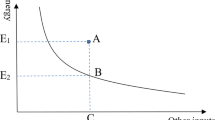Abstract
Coal as the main fuel for the heating industry exerts heavy burdens on China’s environment. Based on meta-frontier non-radial distance function, this paper estimates the total-factor unified integrated efficiency of the thermoelectric industry in 29 provinces and analyzes its dynamic changes using Malmquist index. Besides, the composition of the meta-frontier Malmquist unified integrated efficiency is further evaluated to analyze the spatial-temporal features of the thermoelectric industry. The results show that the average total-factor unified integrated efficiency of the thermoelectric industry in the northern and southern China is 0.572 and 0.587, respectively, over 1999–2014. Although the total-factor unified integrated efficiency of the thermoelectric industry tends to improve, technical progress plays different role in the north and the south. Improvement in the thermoelectric industry in the north mainly relies on technical efficiency, while improvement in the south mainly relies on technical progress. Technological catch-up in both the north and south is weak.






Similar content being viewed by others
References
Agrell, P. J., & Tind, P. B. (2005). DEA and dynamic yardstick competition in Scandinavian electricity distribution[J]. Journal of Productivity Analysis, 23(2), 173–201.
Arcos-Vargas, A., Núnez-Hernández, F., & Villa-Caro, G. (2017). A DEA analysis of electricity distribution in Spain: an industrial policy recommendation[J]. Energy Policy, 102, 583–592.
Ball, V. E., Färe, R., Grosskopf, S., & Margaritis, D. (2010). Productivity and profitability of US agriculture: evidence from a panel of states. New York: Springer.
Barros, C. P., Managi, S., & Matousek, R. (2012). The technical efficiency of the Japanese banks: non-radial directional performance measurement with undesirable output. Omega, 40, 1–8.
Battese, G. E., Rao, D. S. P., & O'Donnell, C. J. (2004). A metafrontier production function for estimation of technical efficiencies and technology gaps for firms operating under different technologies. Journal of Productivity Analysis, 21, 91–103.
Cherchye, L., & Post, T. (2003). Methodological advances in DEA: a survey and an application for the Dutch electricity sector[J]. Statistica Neerlandica, 57(4), 410–438.
Chambers, R. G., Chung, Y., & Färe, R. (1996). Benefit and distance functions. Journal of Economic Theory, 70, 407–419.
Charnes, A., Cooper, W. W., & Rhodes, E. (1978). Measuring the efficiency of decision making units. European Journal of Operational Research, 2, 429–444.
Chung, Y. H., Färe, R., & Grosskopf, S. (1997). Productivity and undesirable outputs: a directional distance function approach. Microeconomics, 51, 229–240.
Färe R., Grosskopf S., Norris M., Zhang, Z. (1994). Productivity Growth, Technical Progress, and Efficiency Change in Industrialized Countries[J]. American Economic Review, 84(5),1040-1044.
Farrell M J. (1957). The Measurement of Productive Efficiency[J]. Journal of the Royal Statistical Society. Series A (General), 120(3), 253-290.
Fukuyama, H., & Matousek, R. (2011). Efficiency of Turkish banking: two-stage network system. Variable returns to scale model. Journal of International Financial Markets Institutions & Money, 21, 75–91.
Fukuyama, H., & Weber, W. L. (2009). Estimating indirect allocative inefficiency and productivity change. Journal of the Operational Research Society, 60, 1594–1608.
Fukuyama, H., & Weber, W. L. (2010). A slacks-based inefficiency measure for a two-stage system with bad outputs. Omega, 38, 398–409.
IPCC, (2006). IPCC Guidelines for National Greenhouse Gas Inventories[R], the Institute for Global Environmental Strategies (IGES) for the IPCC. (https://www.ipcc-nggip.iges.or.jp/public/2006gl/index.html). Accessed 30 Aug 2013.
Ghosh, R., & Kathuria, V. (2016). The effect of regulatory governance on efficiency of thermal power generation in India: a stochastic frontier analysis[J]. Energy Policy, 89, 11–24.
Geymueller, P. V. (2009). Static versus dynamic DEA in electricity regulation: the case of US transmission system operators[J]. Central European Journal of Operations Research, 17(4), 397–413.
Lin, B., & Du, K. (2015). Energy and CO 2 emissions performance in China's regional economies: do market-oriented reforms matter? Energy Policy, 78, 113–124.
Oh, D. H., & Lee, J. D. (2010). A metafrontier approach for measuring Malmquist productivity index. Empirical Economics, 38, 47–64.
Simab M , Haghifam M R . DEA efficiency for the benchmarking of Iranian electric distribution utilities[C]// Electricity Distribution - Part 1, 2009. CIRED 2009. 20th International Conference and Exhibition on. IET, 2009.
Seyoum, E. T., Battese, G. E., & Fleming, E. M. (2004). Technical efficiency and productivity of maize producers in eastern Ethiopia: a study of farmers within and outside the Sasakawa-Global 2000 project. Agricultural Economics of Agricultural Economists, 19, 341–348.
Sueyoshi, T., & Goto, M. (2011). DEA approach for unified efficiency measurement: assessment of Japanese fossil fuel power generation. Energy Economics, 33, 292–303.
Tulkens, H., & Eeckaut, P. V. (1995). Non-frontier measures of efficiency, progress and regress for time series data. International Journal of Production Economics, 39, 83–97.
Wang, K., Wei, Y. M., & Zhang, X. (2013a). Energy and emissions efficiency patterns of Chinese regions: a multi-directional efficiency analysis. Applied Energy, 104, 105–116.
Wang, K., Yu, S., & Zhang, W. (2013b). China’s regional energy and environmental efficiency: a DEA window analysis based dynamic evaluation. Mathematical & Computer Modelling, 58, 1117–1127.
Wang, Q. W., Zhou, P., & Zhou, D. Q. (2010). Research on dynamic carbon dioxide emissions performance, regional disparity and affecting factors in China. China Industrial Economics, 33, 45–54.
Zhang, N., Kong, F., Choi, Y., & Zhou, P. (2014). The effect of size-control policy on unified energy and carbon efficiency for Chinese fossil fuel power plants. Energy Policy, 70, 193–200.
Zhouab, P., & Wang, H. (2012). Energy and CO emission performance in electricity generation: a non-radial directional distance function approach. European Journal of Operational Research, 221, 625–635.
Acknowledgements
This paper is supported by Report Series from Ministry of Education of China (NO.10JBG013).
Author information
Authors and Affiliations
Corresponding author
Ethics declarations
Conflict of interest
The authors declare that they have no conflict of interest.
Additional information
Publisher’s note
Springer Nature remains neutral with regard to jurisdictional claims in published maps and institutional affiliations.
Rights and permissions
About this article
Cite this article
Lin, J., Lin, B. The role of technical progress in China’s northern and southern heating industry. Energy Efficiency 13, 665–682 (2020). https://doi.org/10.1007/s12053-020-09844-w
Received:
Accepted:
Published:
Issue Date:
DOI: https://doi.org/10.1007/s12053-020-09844-w




